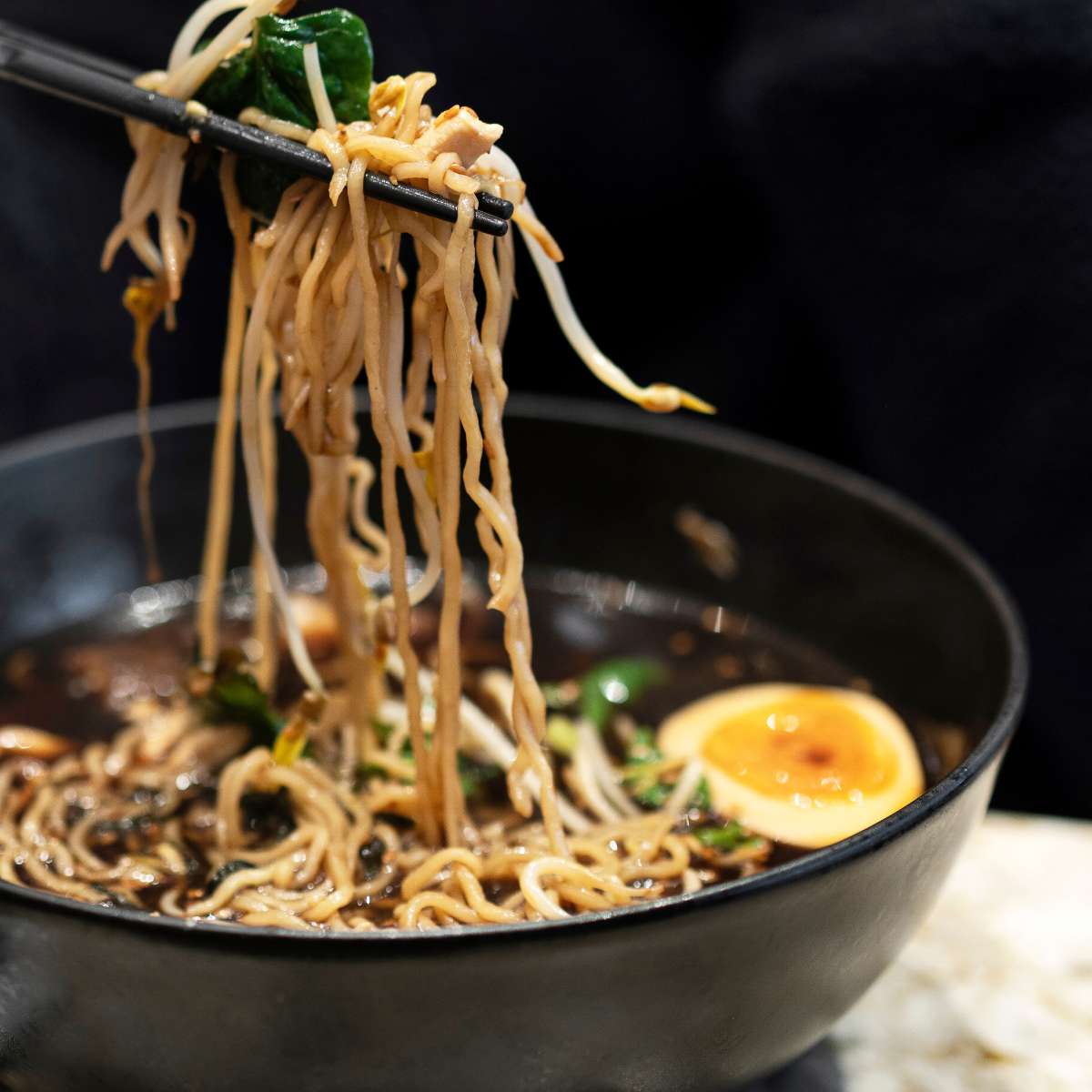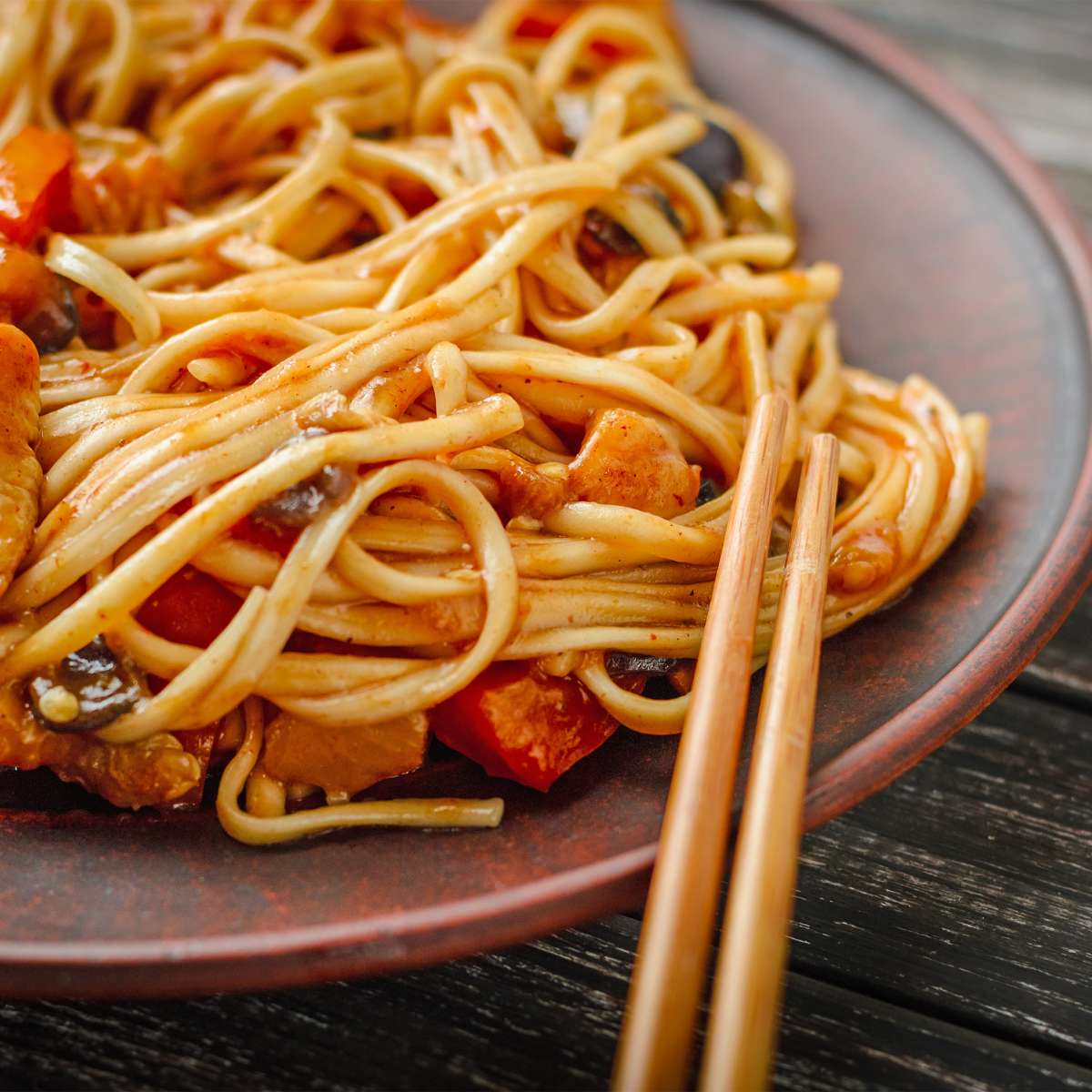Curious about what are udon noodles? These thick, chewy strands that are a staple in Japanese food. Udon noodles stand out for their delightful bounce and smooth texture, making them a favorite in various dishes from soups to stir-fries.
In this article, we’ll explore the origins, culinary uses, and unique characteristics of udon noodles, giving you everything you need to know about this beloved noodle type.
What Are Udon Noodles?
Udon noodles are a quintessential part of Japanese cuisine, known for their thick, chewy texture. These noodles are made primarily from wheat flour, water, and salt, which contribute to their simplicity and comforting qualities. They embody the essence of Japanese culinary tradition, celebrated for their versatility and straightforward preparation.
Udon noodles stand out due to their substantial width, typically ranging from two to four millimeters, making them one of the thicker noodle varieties. They strike a perfect balance between springiness and tenderness, which not only makes them a joy to eat but also a fun challenge for those using chopsticks.
These noodles are commonly served in a variety of ways—immersed in a hot, flavorful broth or featured in a hearty stir-fry. Their ability to adapt to different dishes makes them a beloved choice for both quick meals and elaborate feasts.
Whether dressed up with tempura and vegetables or enjoyed in a simple broth, udon remains a humble yet staple dish in Japan, embodying the minimalist philosophy that less is often more.
Related Article: While exploring udon noodles, you may also be interested in other Japanese staples like ramen and soba. For more insights, visit our articles on “What Are Soba Noodles” and “What Is Ramen.”
Udon’s History
Udon is believed to have been introduced to Japan in the 9th century by Buddhist monks who brought the basic recipe from China. The simplicity of its ingredients made it accessible, and it was gradually integrated into local Japanese diets.
Over the centuries, different regions of Japan began to put their unique twists on udon, leading to a variety of styles. For example, the Sanuki region of Kagawa is famed for its distinctly chewy and thick udon, which has become a point of local pride and a well-known regional specialty.
Udon’s adaptability has allowed it to maintain popularity through various historical periods. It has been a comfort food for the masses, particularly during times of scarcity. Udon’s role in Japanese culture is also highlighted in many festivals and traditions, where it is consumed to bring good fortune and health.
Today, udon continues to be a staple of Japanese cuisine, both within Japan and internationally. Its straightforward preparation and comforting texture have made it a favorite choice in casual dining and fast food settings alike.
The Simple Ingredients Behind Udon
Udon noodles are celebrated for their simplicity and delightful texture, which come from a straightforward mix of ingredients. At its core, udon is made from just three main components:
- Wheat Flour: Wheat flour is the primary ingredient in udon. It gives these noodles their characteristic chewiness and substantial body. High-gluten flour is typically used to achieve the noodles’ desired texture.
- Water: Essential for forming the dough, water is mixed with flour to create udon’s distinct thick strands. The amount of water added affects the dough’s texture, influencing the noodle’s final chewiness.
- Salt: Salt is added to the dough to enhance the flavor and also to strengthen the gluten in the flour, which helps the noodles maintain their structure when cooked.
These ingredients are combined to form a dough, which is then kneaded, rolled out, and cut into thick strands. The simplicity of its ingredients allows the natural flavors and textures of the noodles to shine through in various dishes.
Related Article: Now that you know the ingredients behind udon, you might also be curious about what goes into making ramen noodles. Check out our article on “What Are Ramen Noodles Made Of.”
Mastering Udon: The Craft Behind the Noodles
Making udon noodles is an art that combines traditional techniques with a touch of personal flair. It’s not just about mixing ingredients; it’s about creating something special with every roll and cut of the dough.
Kneading and Rolling
The process begins with kneading the dough, a critical step that sets the foundation for perfect udon. This isn’t a rushed job but a careful, deliberate process where the dough is massaged and worked until it becomes smooth and elastic. This ensures the noodles have the right texture and firmness.
Once the dough reaches the ideal consistency, it’s rolled out. This is where precision meets artistry. The goal is to roll the dough evenly, ensuring uniform thickness before cutting. A rolling pin helps stretch the dough into a thin layer, ready for the next step.
Cutting the Noodles
The final step in making udon is cutting the dough into strips. This requires a sharp knife and a steady hand to ensure each noodle is the same width, which is crucial for consistent cooking. The thickness can vary depending on personal or regional preferences, but typically, udon noodles are thicker than most other types, offering a satisfying chew.
Every slice of the knife is a careful, considered motion that turns the flat sheets of dough into long, slender noodles. This part of the process is not just about following a technique but also about honoring a tradition that dates back hundreds of years.
Udon vs. Other Noodle Types: Ramen, Pho, and Soba
Exploring the diverse world of noodles, udon stands out distinctly when compared to other popular types such as ramen, pho, and soba. Here’s how these noodles differ:
- Udon vs. Ramen: Udon noodles are thick and chewy, made from wheat flour, water, and salt, resulting in a plump and soft texture ideal for absorbing hearty broths. Ramen noodles, on the other hand, are thinner, slightly elastic, and made with wheat flour and kansui, giving them a yellow hue and a springy feel. While udon is typically served in a light dashi-based broth, ramen comes in a richer, often meatier broth, enhancing its distinct flavors.
- Udon vs. Pho: Udon, a staple in Japanese cuisine, contrasts with pho noodles from Vietnamese culinary traditions. Pho noodles are made from rice flour, making them thinner and more delicate than udon. Pho is served with a clear, spice-infused broth and fresh herbs on the side, offering a lighter dining option compared to the often more robust udon dishes served hot with various toppings.
- Udon vs. Soba: Soba noodles, crafted from buckwheat flour, offer a nutty taste and a darker color, contrasting with udon’s mild and smooth wheat-based noodles. While soba can be enjoyed both hot or cold with a dipping sauce or in a broth, udon’s thick strands are particularly suited for soaking up flavors in hot soups.
Each noodle type presents a unique culinary experience, from the hearty chew of udon to the delicate bite of pho, the robust texture of ramen, and the earthy subtlety of soba.
Savoring the Variety: Types of Udon Dishes
Udon noodles come in many delightful varieties, each offering a unique taste and texture experience. Here’s a guide to some popular types of udon dishes:
Kake Udon: The Comfort Classic
Kake Udon is the epitome of udon comfort food. Served in a hot soy-based broth, it’s garnished with crisp green onions. This dish is simple yet profoundly satisfying, perfect for warming up during cooler weather.
Tempura Udon: Crispy Meets Chewy
Tempura Udon brings a delightful crunch to the soft, chewy noodles. It combines tempura-fried vegetables or seafood with udon in a rich broth, creating a satisfying textural contrast. Each bite offers a crunchy complement to the noodles, making it a favorite for those who enjoy a bit of variety in their bowl.
Yaki Udon: Stir-Fried Sensation
Yaki Udon takes the noodles out of the broth and into the frying pan. This stir-fried dish is packed with vegetables and your choice of protein, all coated in a flavorful sauce. It’s a hearty and versatile dish that’s perfect for a filling meal.
Inaniwa Udon: Silky and Smooth
Inaniwa Udon is known for its thinner, smoother texture compared to other udon types. Hand-stretched and air-dried, this variety is less chewy and often served cold, making it a refreshing option during warm weather.
Sanuki Udon: Chewy and Thick
Sanuki Udon, from Kagawa prefecture, is famous for its al dente texture and thickness. It’s ideal for broth-based dishes, where it absorbs flavors beautifully, providing a satisfying chew with every slurp.
Nutritional Benefits of Udon
Udon noodles are not only a feast for the senses but also a source of several nutritional benefits that complement a balanced diet. Here’s a simpler breakdown of what these hearty noodles offer:
- Sustained Energy: Udon noodles are packed with complex carbohydrates, which provide a steady release of energy. This makes them an excellent choice for maintaining energy levels throughout the day without the spikes and drops associated with simpler sugars.
- Low in Fat: Udon noodles are naturally low in fat, making them a heart-healthy option for those looking to manage their dietary fat intake.
- Protein Pairings: While udon itself is not high in protein, it pairs wonderfully with various protein sources like tofu, chicken, or seafood, creating a balanced meal that supports muscle repair and growth.
- Versatile and Filling: Udon’s dense and chewy texture makes it particularly satisfying, helping to control hunger and thereby supporting weight management efforts.
- Rich in Micronutrients: Depending on how they are served, udon dishes can be enriched with vitamins and minerals when combined with vegetables and lean proteins, boosting the overall nutritional content of your meal.
Incorporating udon into your diet provides a delicious way to enjoy a meal that’s both comforting and beneficial to your health. So, whether you’re looking for an energy boost or a fulfilling meal, udon noodles can be a versatile and nutritious choice.
Related Article: Now that you’ve learned all about udon, you might be curious about how it compares to another popular Japanese noodle, soba. Check out our article on “Udon vs Soba Noodles” to discover the differences and unique qualities of each.
Conclusion
As we conclude our journey into the world of udon, it’s evident that these noodles are a vital part of Japan’s culinary heritage. Udon noodles offer a unique blend of comfort and simplicity, making them a beloved choice for both traditional and innovative dishes.
Whether served in a warming broth or mixed into a vibrant stir-fry, each udon dish invites you to experience a slice of Japanese culture and culinary craftsmanship.
FAQ
How are udon noodles typically served?
Udon can be served in many ways, including in a hot broth as a soup, stir-fried, or chilled with a dipping sauce.
What makes udon different from other Japanese noodles?
Udon noodles are thicker and chewier than other Japanese noodles like soba (buckwheat noodles) and ramen (thin, curly noodles), which distinguishes them in texture and taste.
Can udon noodles be used in vegetarian dishes?
Yes, udon noodles are naturally vegan and can be used in vegetarian and vegan dishes by pairing them with plant-based broths and toppings.
What are some common toppings or ingredients added to udon dishes?
Common toppings for udon include scallions, tempura, thinly sliced meats like pork or beef, nori, and various mushrooms. Broths can vary from light soy-based to rich miso or creamy curry.
How do you store udon noodles?
Dry udon noodles can be stored in a cool, dry place for several months. Cooked udon should be kept in the refrigerator and consumed within a couple of days. Fresh udon noodles should also be refrigerated and used by the recommended date on the package.
What is the best way to cook udon noodles?
Udon noodles should be cooked in boiling water for about 8 to 10 minutes, or until they are tender but still have a slight chewiness. They should then be rinsed under cold water to stop the cooking process and remove excess starch.






